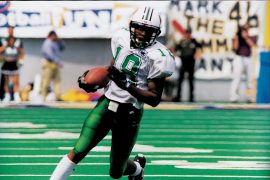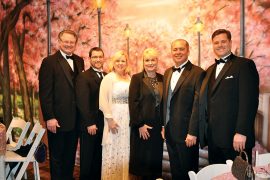With more than 40 years of history at his disposal, Ernie Salvatore assembles the ultimate Herd attack
By Ernie Salvatore
HQ 2 | WINTER 1990
The history of Marshall University sports echoes with the footsteps of many great athletes. Ever since a tradition of basketball excellence emerged from the basement of the Old Main Auditorium, where games were first played, fans have pondered the questions: Who were the best players? Who was the best coach? Which team dominated its era?
Ernie Salvatore, the veteran sports columnist and former sports editor of The Herald Dispatch, has witnessed the basketball program’s rise to prominence. The Connecticut Yankee first learned of a place called Marshall College when he saw its basketball team beat up on City College of New York, a nationally ranked team, 60-26. He was impressed enough to pack his bags and head south.
Today, nearly 50 years later, Ernie Salvatore is a household name in Huntington. He is the only sports writer in the nation who has covered Marshall University athletics for more than 45 years. If anyone has the guts and expertise to tackle these lingering questions and assemble a “Dream Team, ” it’s Ernie …
Picking so-called “dream teams” can become a nightmare unless you let your conscience be your guide.
Mine guided me as I picked my Marshall basketball dream team for the Huntington Quarterly. Aided further by five measuring factors to separate my dream five from the enormous pack, my task was eased considerably. After all, in 45 years you get to see a lot of players.
On the basis, then, of speed, agility, shooting, work ethic and pro draft status, Hal Greer, Russell Lee, Mike D’Antoni, George Stone and Walt Walowac emerge, in my dream of dreams, as the greatest Thundering Herd five in history.
By adding fiery Ken Labanowski as my number six man coming off the bench, I’d match my five against any team in the country, mano y mano as they say in the bull rings, and that’s no bull if Cam Henderson, Jule Rivlin, or Carl Tacy were doing the coaching.
Lee, Stone, Walowac and Greer all own Marshall Top 10 career scoring averages. D’Antoni’s three year assist record is only 42 shy of Greg White’s four year mark. Most important, all five were high picks in the NBA and ABA drafts when there were a dozen fewer teams compared with today’s league.
Lee was the No. 1 pick of the Milwaukee Bucks. D’Antoni was the No. 2 of the Kansas City (Sacramento) Kings and No. 1 of the ABA San Antonio Spurs. Stone was No. 2 of the ABA Carolina Cougars, Greer No. 2 of the Syracuse NationalsPhiladelphia 76ers. His 15 year NBA career tops anything to come out of Marshall. Walowac declined an NBA career to star, instead, with the Akron Goodyears of the National Industrial Basketball League – in his prime, an often preferred alternative to the NBA – for more than ten years.
Now let’s take them one at a time.
I. Hal Greer

Hal Greer has the distinction of being the only Marshall player to have a Huntington street named after him. However, it isn’t Hal Greer Boulevard, or his long list of records that won my vote. And, it isn’t the fact that Greer was the first Black player to enter a “white” college in West Virginia. It’s because Hal Greer was the fastest man I ever saw on a Marshall court. He also had great hands that made him a superb shooter and gifted ball handler.
When he arrived at Marshall, he was a timid kid trying to adjust to a strange new world and he was lonely. His grandmother, who helped to raise him, said that every day he left his house on Doulton Avenue for Marshall in his freshman year, her heart went out to him. But his coach loved him and that coach was Jule Rivlin. Rivlin understood Greer – Rivlin was a minority himself. So they established a great rapport, and Rivlin’ s teaching helped Hal mature in to a great player.
His stamina was remarkable. He could run just as hard at the end of a game as he could at the start. In his three year, 71 game career, he averaged 19.4 points a game, totaling 1,377 points.
II. Russell Lee
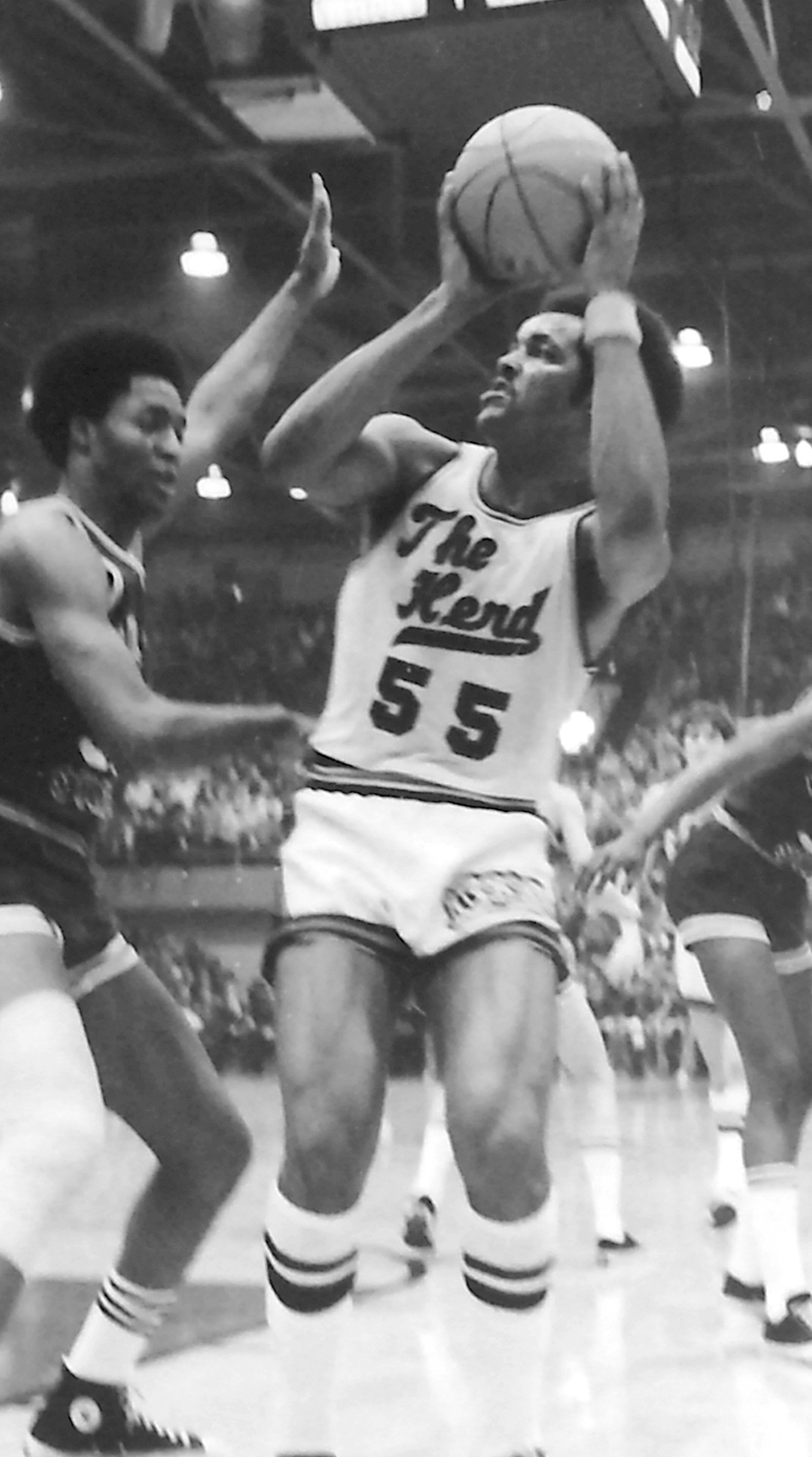
Hailing from Boston, Mass., Russell Lee was a hot high school prospect. It was Ellis Johnson who recruited him. In fact, Johnson worked closely with the legendary Red Auerbach of the Boston Celtics in constructing Lee’s college career. The Celtic boss wanted Lee developed as a guard in preparation for his pro career. Unfortunately, in his three years at Marshall, the versatile athlete had to play three different positions under three different coaches.
Nevertheless, Russell Lee was special. Not only is he Marshall’s all-time scoring average leader with a 23.9 average, but he played the back court, power forward and center with equal skill that earned him national recognition. He’s the best all-around player I’ve seen at Marshall. In 76 games he scored 1,815 points and hauled in 863 rebounds, No. 4 at Marshall in that category.
Ill. Mike D ‘Antoni
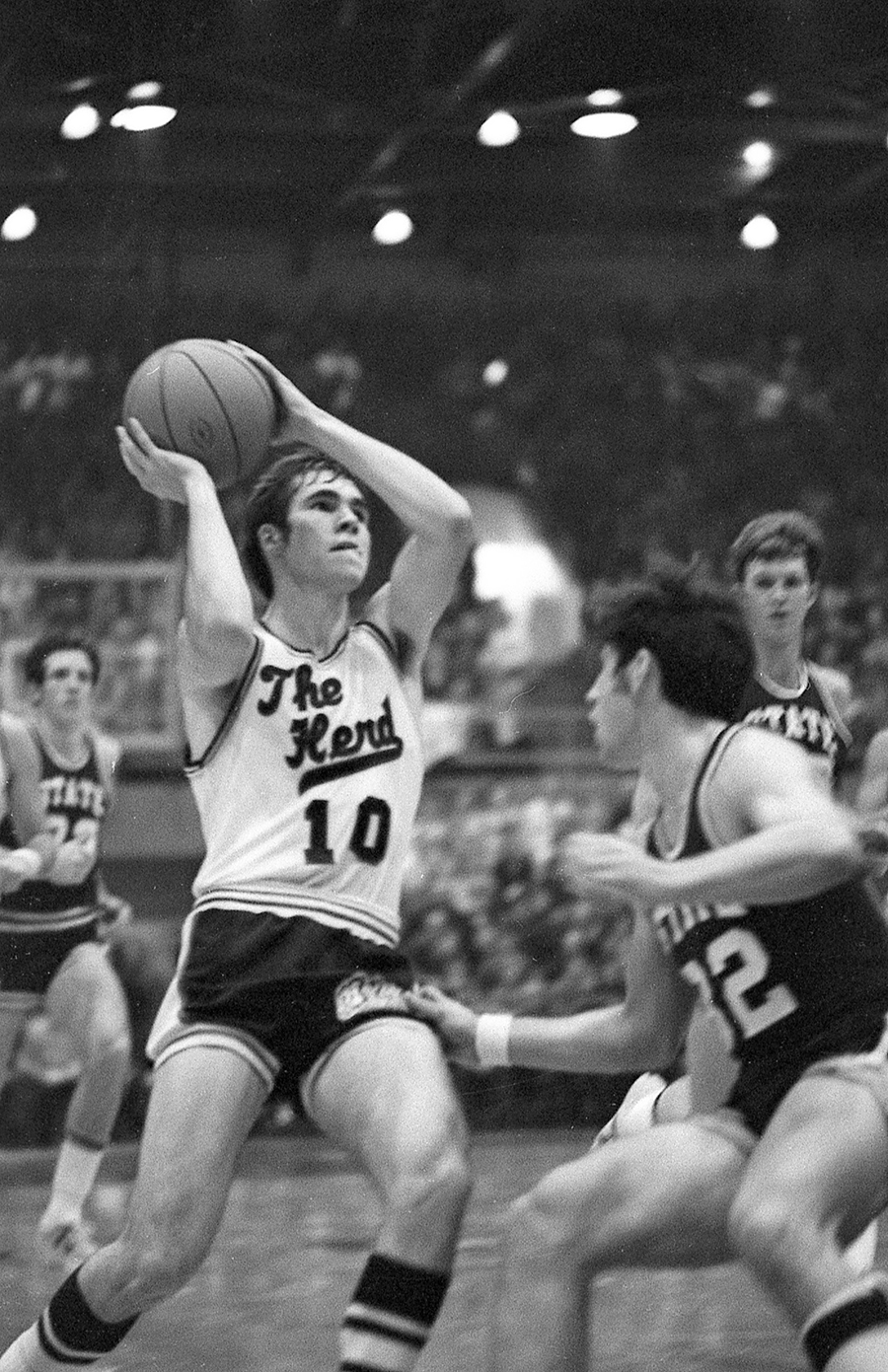
Mike D’Antoni carries a great family name at Marshall. The Mullens, W.Va. native with the boyish good looks was a classic point guard. He was a skilled ball handler with peripheral vision and an amazing 76″ arm span – two of the reasons he’s still the three year record holder at Marshall for assists, with 659. And, as Ellis Johnson and Carl Tacy observed, D’Antoni always knew where he was on the court. He wasn’t a shabby scorer, either, with 1,227 points in just 80 games for a 15.2 average. Today, he’s still starring for Milan in the Italian League.
IV. George Stone
George Stone was an impact player. He was a deadly outside shooter and an outstanding offensive threat, one of Marshall’s best.
The night he scored 38 points against Nebraska in the 1967 NIT in Madison Square Garden was vintage Stone. He absolutely set New York City on its ear that night.
Stone forced defenses to pay attention to him. Opposing coaches learned that a high percentage shot for George was a 25 footer. Today, he’d be a 3 point goal sensation. He scored 1,723 points in only 77 games, and his 22.4 point average is No. 3 on Marshall’s all-time list.
V. Walt Walowac

People tend to forget Walt Walowac. For nearly 35 years he held Marshall’s alltime scoring record with 1,982 points, although he played in only 95 games in less than three and a half seasons. If Walowac would have had the three point goal and 27 game schedule at his disposal, they’d still be chasing him, including the current point leader Skip Henderson.
He was the best shooter I ever saw at Marshall. I saw him hit 13 straight jumpers against Ohio one night in Athens. Most of all, I loved his nerves. With the game on the line, he wanted the ball.
*Jule Rivlin
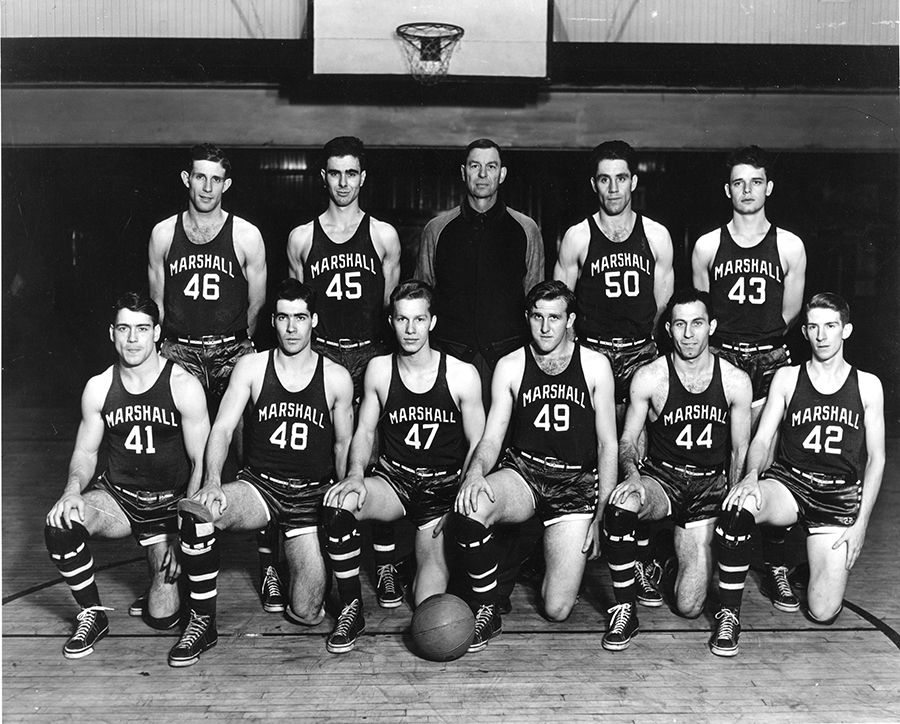
I never saw Riv play, that’s why I didn’t name him to the team. However, I respect him deeply as a player and coach. This is a man who pioneered the behindthe-back-pass 20 years before Bob Cousey, and did other things with the basketball 30 years before they became common practice. He was Marshall’s first authentic All-American as well as the No. 2 scorer in the nation as a sophomore. He’s probably the best all-around player to wear a Marshall uniform.
Best 6th Man: Ken Labanowski
The man went belly up with everybody, especially with guys who were bigger and stronger. He played like a street fighter.
It’s interesting how he got that tough. He came from a well-to-do family on Long Island. His father was a Wall Street stockbroker, but Ken would go over to Brooklyn and beg for a chance to play with the black kids on their playgrounds. Of course, he had to fight his way up to earn his credentials, and when they finally accepted him, he was very proud. He’s No. 18 on Marshall’s scoring list and No. 8 in rebounds with 751.
Best Coach: Cam Henderson
The arena is named after him, and with good reason. Just consider his contributions to the game. He invented the zone defense in 1914, and off of that developed the three man fast break, when basketball was a slow game. If Cam had a flaw as a coach, it was his stubbornness. But, this also made him an attractive person. He was convinced that when he reached a decision, it was the right decision. In 20 seasons at Marshall, his record was 362 wins and only 160 losses, including a win for the 1946-47: 7 NAIB Championship.
It always amuses me that there’s that picture of him up there at the arena, staring down at the ball games, watching these people try to play the game he practically invented.
Best Competitor: Leo Bird
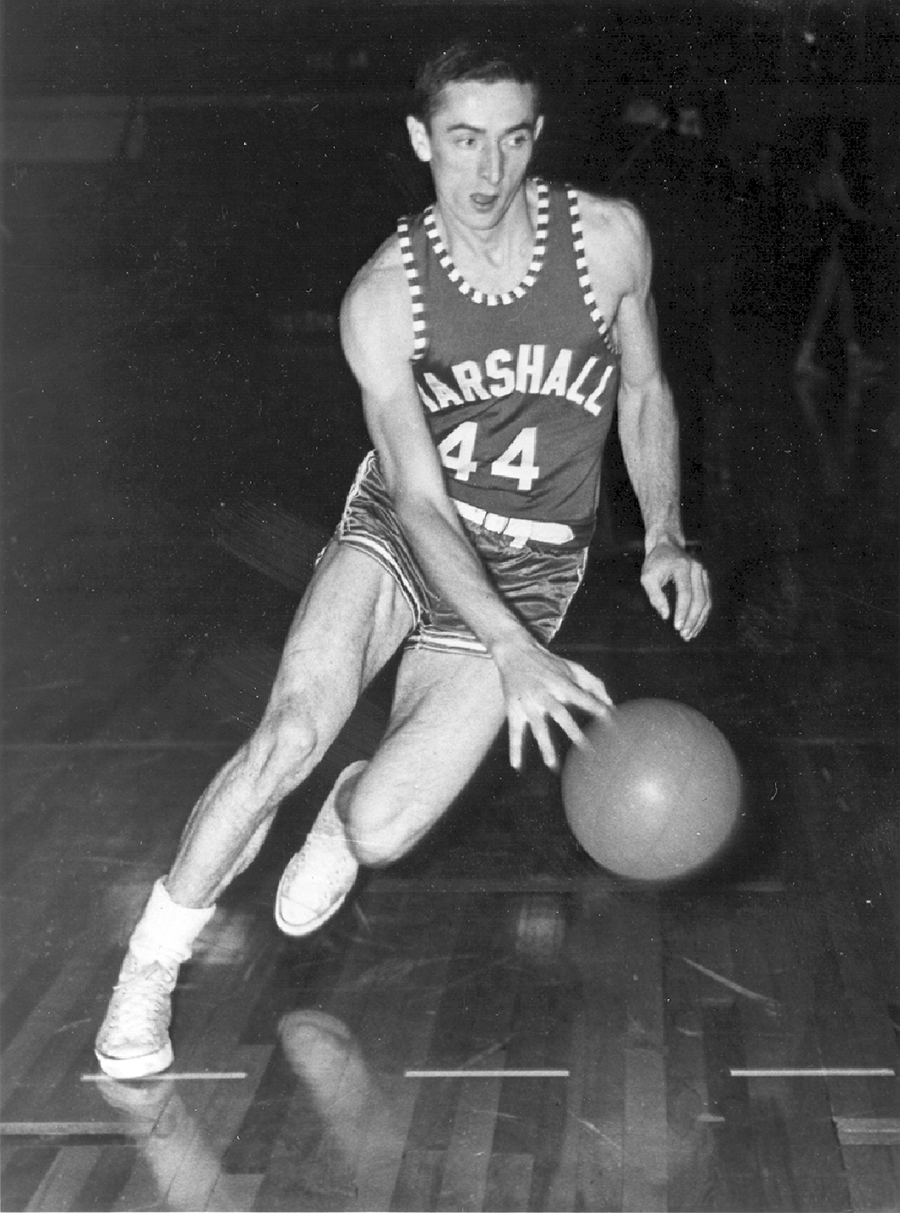
Here’s a guy who deserves special mention. He played in the Pan American games with Jerry West and Oscar Robertson and survived until the final cut for the 1960 Olympic team. Leo became a great ball player out of sheer will power. He is Marshall’s No. 2 single season scorer with 702 points, and No. 2 in career scoring average, with 23.5.
Best Rebounders: Charlie Slack & Rodney Holden
Charlie Slack was another fierce competitor. Although he was only 6′ 5″, he played more like he was 6′ 10″. He still holds the NCAA single season record for average rebounds per game, 25.6. He hauled in 1,916 at Marshall in 88 games. Rodney Holden would have to emerge as the best rebounder of the modern era. This was a young man who could electrify people. He was a real showman, the consummate performer. The bigger the crowd, the better he played. The Marshall fans inspired him.
The Best of the Rest:
Best Teaching Coach: Jule Rivlin
Best Bench Coach: Carl Tacy
Best Shooter: Walt Walowac
Best Point Guard: Mike D’Antoni
Best Ball Handlers: Bill Toothman, Cebe Price, Greg White
Best Playmaker: Mike D’Antoni
Best Foul Shooter: Bunny Gibson
Best Teams: 1946-47 NAIB Champs, 1971-72 Team, 1983-84 S.C. Champs


